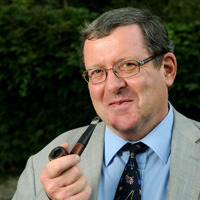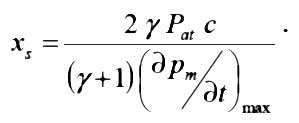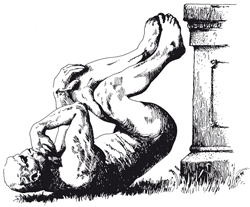Marc Abrahams's Blog, page 510
March 5, 2013
The gait of the shoeless
This study looks at the gait of the shoeless:
“To what extent does not wearing shoes affect the local dynamic stability of the gait? Effect size and intra-session repeatability,” Philippe Terrier, Fabienne Reynard, http://arxiv.org/abs/1212.5510, March 5, 2013. (Thanks to investigator Francis Villatoro for bringing this to our attention.) The authors, at Institute for Research in Rehabilitation, Sion, Switzerland, write:
“Local dynamic stability (LDS) quantifies how a system responds to small perturbations. Several experimental and clinical findings have highlighted the association between gait LDS and fall risk. Walking without shoes is known to slightly modify gait parameters. Barefoot walking (BW) may cause unusual sensory feedback to individuals accustomed to shod walking (SW), and this may impact on LDS. The objective of this study was therefore to compare the LDS of SW and BW in healthy individuals and to analyze the intrasession repeatability. Forty participants traversed a 70 m indoor corridor wearing normal shoes in one trial and walking barefoot in a second trial. Trunk accelerations were recorded with a 3D-accelerometer attached to the lower back. The LDS was computed using the finite-time maximal Lyapunov exponent method…. [It] seems that BW can be used to evaluate LDS without introducing bias as compared to SW, and with a sufficient reliability.”
 BONUS (unrelated): A different Professor Philippe Terrier:
BONUS (unrelated): A different Professor Philippe Terrier:

Elephant Trumpets, the Acoustics of
“Because trumpeting is often associated with intensely social events, expressing the very high level of excitement and importance of the event, it is not easy to ask elephants for trumpet calls!”
But that did not deter a research team at the Laboratoire d’Acoustique de l’Université du Maine, Le Mans, France (assisted by the Zoo de Beauval, Saint-Aignan) from collecting audio samples of elephants’ trumps in order to perform the first (?) scientific investigation into the acoustical complexities of their production.
“The internal bore of the vocal system of the elephant, from the vocal folds to the open end radiating the sound – trunk end – is several meters long, like brass instruments. The vocal system is so long than the nonlinear steepening effect might be significant during elephant trumpeting.”
 The team worked with mathematical formulae [see full paper for details] which might closely represent the acoustic phenomena occurring during trumpeting, and tested their relevance against recordings of two types of trumps – so-called ‘brassy’ and ‘non-brassy’.
The team worked with mathematical formulae [see full paper for details] which might closely represent the acoustic phenomena occurring during trumpeting, and tested their relevance against recordings of two types of trumps – so-called ‘brassy’ and ‘non-brassy’.
“Elephant trumpet calls are powerful sounds having a rich harmonic structure, sounding like brassy sounds of musical instruments. Note that it is quite easy to imitate elephant trumpet calls with a trombone! To answer the speculative question about nonlinear propagation effects in trumpet calls, a first answer was obtained by estimating a realistic critical shock length distance xs: the shock length distance xs is comparable to the trunk length. It means that nonlinear distortion during propagation inside the trunk is relevant, and the brassy aspect of trumpet calls can be explained as a consequence of nonlinear propagation in the extended vocal tract (including the trunk). In other words, the explanation of the brassy aspect of the elephant trumpet calls seems to be the same as the explanation of the brassy sounds from trumpet or trombone musical instruments.”
Two stereo recordings (both in low-level .wav format) are provided for download :
one of an elephant, and another of a trombone imitating an elephant.
The full paper : Does the elephant trumpet like a trumpet? was presented at the
International Congress on Acoustics ICA2010: (20th International Congress on Acoustics, Sydney, Australia, 23-27 August, 2010.)

Hamburger moments for mathematicians

Two tasty studies, for mathematicians who enjoy this sort of thing:
1. “ON THE BACKWARD EXTENSION OF POSITIVE DEFINITE HAMBURGER MOMENT SEQUENCES,” Fred M. Wright, Proceedings of the American Mathematical Society, vol. 7, 1956, pp. 413-22.
2. ”An Extended Hamburger Moment Problem,” Olav Njåstad [pictured here], Proceedings of the Edinburgh Mathematical Society (Series 2) (1985), 28 : pp 167-183.

March 3, 2013
The Ig Nobel tour of Denmark starts tonight, in Aarhus!
 The 2013 Ig Nobel Tour of Denmark starts tonight — Monday, March 4 — at the University of Aarhus. There will be a second show there tomorrow night, Tuesday, March 5.
The 2013 Ig Nobel Tour of Denmark starts tonight — Monday, March 4 — at the University of Aarhus. There will be a second show there tomorrow night, Tuesday, March 5.
On Wednesday night, March 6: Odense.
And on Thursday night, March 7: Copenhagen.
(After that: The Ig Nobel show in Stockholm, Sweden. And after that, the Ig Nobel tour of the UK.)

A Flying Lizard (extinct) and a Famous Cartoonist (extant)
 In answer to the question “How many monofenestratan pterosaurs are named after famous cartoonists?”, Improbable hazards a guess that the answer is :“One”.
In answer to the question “How many monofenestratan pterosaurs are named after famous cartoonists?”, Improbable hazards a guess that the answer is :“One”.
Being : Cuspicephalus scarfi which is named (say its describers David Martill and Steve Etches of the School of Earth and Environmental Sciences at the University of Portsmouth, UK) “After artist/cartoonist Gerald Scarfe whose vicious caricatures mostly have very pointy noses. “
A paper describing the creature can be read in full here: ‘A monofenestratan pterosaur from the Kimmeridge Clay Formation (Upper Jurassic, Kimmeridgian) of Dorset, England.’(accepted for publication in Acta Palaeontologica Polonica.)
Note : The images, provided for comparison, depict the ‘nose’ of the animal (based on a partially coherent old fossil) and Gerald Scarfe’s ‘Torydactyl’ (based on Margaret Thatcher).
Supporting info via

Trombonists’s mouth, seem from without and within
Investigator David Finlayson alerts us to this video from a camera inside a trombonist’s mouth:
It complements a video (which we looked at a while ago) of a trombonist’s mouth as seen from a camera mounted on a trombone:
NOTE: Yes, I made a bad typing error (though not quite an unseemly error, let alone a seamy error) in the headline of this post.

March 2, 2013
Eating leather
Two reports about eating leather (allegedly and really):
1. From 1891, in the report “Report on a beetle destroying boots & shoes in Sydney,” by Walter Wilson Froggatt, on page 4:
2. 1980, in the film “Werner Herzog Eats His Shoe“:

Higgs, bosun
Investigator Kurt Verkest sends news of Higgs, bosun. He saw this report in the Seattle PI:
Standing in front of the USS Independence in Bremerton, Bud Higgs, a retired Navy boatswain’s mate, holds a picture of the USS Washington. Higgs served on the Washington, a distinguished but little-known World War II battleship.
BONUS (unrelated): The Higgs boson
BONUS: Higgs, bosonist

March 1, 2013
The Presence of P’s in an Eating Disorder Study
P’s place prominently in the title of this study on in an eating disorders:
“Persistence, Perseveration and Perfectionism in the Eating Disorders,” Glenn Waller, Tonya Shaw, Caroline Meyer, Michelle Haslam, Rachel Lawson and Lucy Serpell, Behavioural and Cognitive Psychotherapy, epub 2012. The authors, at King’s College London, UK, at Karen Surgery, Nairobi, Kenya, at Loughborough University, UK, at Princess Margaret Hospital, Christchurch, New Zealand, and at University College London, UK, explain:
“Perseveration, persistence and perfectionism are traits that have been suggested to be relevant to the eating disorders. his study explored the levels and correlates of these three traits in the eating disorders and control groups.”

February 28, 2013
A blueprint for (almost) everything
 Physicists, philosophers and artists who have been struggling to understand the intricacies, enigmas and counterintuitivenesses of the structure of the universe now have a new resource which might help them – a ‘Useable Electromagnetic Blueprint of the Structure of Space’. For which a company called Hyperspace Pty Ltd (headed by inventor Christopher Heyring of Eagle Bay, Australia) has recently applied for patents in the US, and more than 150 other countries (via the World Intellectual Property Organization )
Physicists, philosophers and artists who have been struggling to understand the intricacies, enigmas and counterintuitivenesses of the structure of the universe now have a new resource which might help them – a ‘Useable Electromagnetic Blueprint of the Structure of Space’. For which a company called Hyperspace Pty Ltd (headed by inventor Christopher Heyring of Eagle Bay, Australia) has recently applied for patents in the US, and more than 150 other countries (via the World Intellectual Property Organization )
The invention not only provides unique insights regarding the multi-dimensional topology of electromagnetic fields but also touches on the Theory of Everything, dark matter, and the elusive Higgs bosun [sic]. Inherent complexities make it hard for Improbable to succinctly summarise the text, but here is one sentence from the patent application which might help to clarify :
“A useable electromagnetic blueprint of the structure of space, comprising a modular form described as a geometrical body having a main central axis and four outer points perpendicularly disposed around the main central axis, and the distance between the four outer points being the same as, the length of the main central axis, such that the four outer points describe a square half way along and around the main central axis thereby describing a figure with six points, four lines of the same length extended from each end of the main central axis to the four outer points and four hyperbolic paraboloid minimal surfaces thereby being defined between the said eight lines arranged radially around the main central axis, thereby defining a modular volume to be called a first hyperhedral unit such that four additional second hyperhedral units may be contiguously and perpendicularly arranged around the first hyperhedral unit, and such further third hyperhedral units may be close packed around the second hyperhedral units and such that the arrangement may be repeated in the same manner in each direction to describe a modular matrix which may be used for various purposes such as tools to analyze aspects of the hyperhedrally defined structure of space in terms of discreet collections and arrangements of hyperhedra.“
More on the Higgs Bosun [sic] here
We strongly encourage readers to persevere and examine the entire patent application, even if it’s only to view and consider the many intriguing diagrams – like this one :

which depicts a ‘magnetic circuit extending around a conductor’, or this one :

showing an ‘alternative connection of perpendicularly arranged conductors.’

Marc Abrahams's Blog
- Marc Abrahams's profile
- 14 followers




